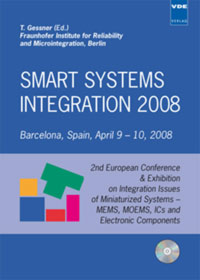Wearable self-powered wireless devices with thermoelectric energy scavengers
Konferenz: Smart Systems Integration 2008 - 2nd European Conference & Exhibition on Integration Issues of Miniaturized Systems - MOMS, MOEMS, ICS and Electronic Components
09.04.2008 - 10.04.2008 in Barcelona, Spain
Tagungsband: Smart Systems Integration 2008
Seiten: 8Sprache: EnglischTyp: PDF
Persönliche VDE-Mitglieder erhalten auf diesen Artikel 10% Rabatt
Autoren:
Leonov, Vladimir; Hoof, Chris Van; Torfs, Tom; Yazicioglu, Refet Firat; Fiorini, Paolo (Interuniversity Microelectronics Center (IMEC), IPSI Department, Leuven, Belgium)
Gyselinckx, Bert; Vullers, Ruud J. M. (Holst Centre / IMEC-NL, Wireless Autonomous Transducer Solutions Department, Eindhoven, The Netherlands)
Inhalt:
The wearable wireless sensors powered with human body heat, which have been developed at IMEC and Holst Centre starting 2004, demonstrated that the power obtainable on the human body is large enough to power practical applications. The improving performance characteristics of the thermoelectric generators (TEGs) on human skin were accompanied by the multi-fold reduction of the power consumption used by the electronics. Such matching of the power consumed to the produced one allowed the first medical device, a wireless pulse oximeter, with no battery in it. In this work, a more complex device, the wireless 2-channel EEG system, has been developed and tested. On one hand, the TEG in this system is the most powerful one among the TEGs fabricated to the moment: at 23 °C, it produces over 2 mW at about 1.8-2 V. On the other hand, low power both electronics and biopotential readout ASIC allow operation of the EEG system at 0.8 mW consumption, so that the TEG has obvious power reserve to supply energy at higher ambient temperatures if necessary. The second device presented in this work is a wrist TEG, the first device operating at the theoretical limit of power production on man, which at 22 °C is about 25 muW/cm2 (depends on thickness of a TEG) at a thermoelectric figure-of-merit ZT of 0.85. This device has been designed to answer the questions: (1) how much power can be produced on man in a real life, especially, in hot weather, and (2) what is the maximal ambient temperature at which the body-powered devices can work. The related sensor has been fabricated to measure and transmit the data to a laptop.


